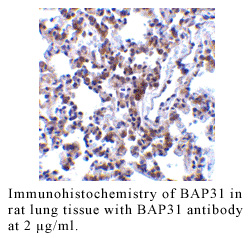Anti-Human B Cell Receptor-Associated Protein 31 (CT) (BAP31)
Data
- -
- -
Antibody DetailsProduct DetailsReactive Species Human Host Species Rabbit Immunogen PN:B499 Product Concentration 0.5 mg/ml Formulation This polyclonal antibody is formulated in phosphate buffered saline (PBS) pH 7.4 containing 0.02% sodium azide as a preservative. Storage and Handling This polyclonal antibody is stable for at least one week when stored at 2-8°C. For long term storage, aliquot in working volumes without diluting and store at –20°C in a manual defrost freezer. Avoid Repeated Freeze Thaw Cycles. Country of Origin USA Shipping Next Day Ambient RRIDAB_2828221 Each investigator should determine their own optimal working dilution for specific applications. See directions on lot specific datasheets, as information may periodically change. DescriptionDescriptionSpecificity Rabbit Anti-Human B Cell Receptor-Associated Protein 31 (BAP31) recognizes an epitope near the C-terminus of Human, Mouse and Rat BAP31. This polyclonal antibody was purified using affinity chromatography. Background Bap31 and the related protein Bap29 are endoplasmic reticulum (ER) and ER-vesicle membrane proteins and members of the B-cell receptor-associated protein family.1,2 These two proteins are highly homologous and can form homo- and heterodimers. Bap31 is thought to be involved in the intracellular trafficking of several molecules such as MHC Class I molecules and CD11b/CD18.3,4 It may also play a role in the initiation of ER stress-induced apoptosis through its association with caspase-8 via a death effector domain in its cytoplasmic tail, possibly through the promotion of membrane fragmentation and the release of cytochrome c from mitochondria. Bap31 itself contains two caspase cleavage sites and is cleaved during apoptosis. The p20 fragment of Bap31, when expressed ectopicially, is also a potent inducer cell death. References & Citations1. Kim, KM. et al. (1994) EMBO J. 13:3793 2. Paquet, ME. et al. (2004) J. Immunol. 172:7548 3. Zen, K. et al. (2004) J. Biol. Chem. 279:44924 4. Nguyen, M. et al. (2000) Mol. Cell. Biol. 20:6731 Technical ProtocolsCertificate of Analysis |
Related Products
- -
- -




